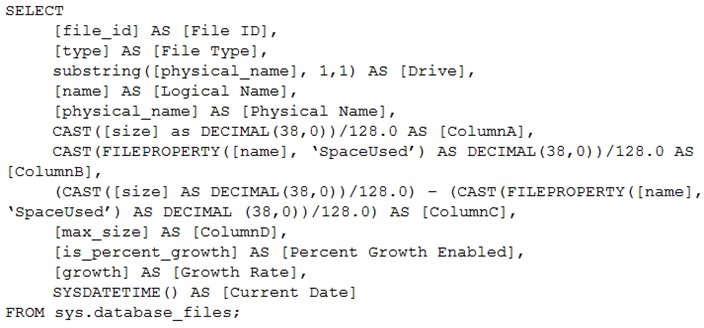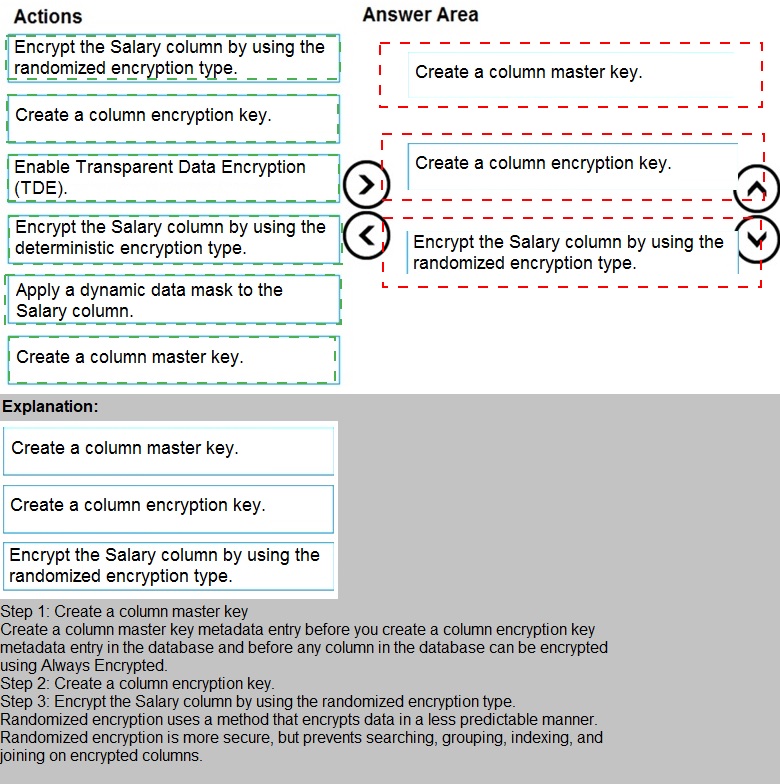
- Email support@dumps4free.com

Topic 5: Misc. Questions
You have the following Transact-SQL query
Which column returned by the query represents the free space in each file?
A.
ColumnA
B.
ColumnB
C.
ColumnC
D.
ColumnD
ColumnC
Explanation:
Example:
Free space for the file in the below query result set will be returned by the FreeSpaceMB
column.
SELECT DB_NAME() AS DbName,
name AS FileName,
type_desc,
size/128.0 AS CurrentSizeMB,
size/128.0 - CAST(FILEPROPERTY(name, 'SpaceUsed') AS INT)/128.0 AS FreeSpaceMB
FROM sys.database_files
WHERE type IN (0,1);
Reference:
https://www.sqlshack.com/how-to-determine-free-space-and-file-size-for-sql-serverdatabases/
You have an Azure SQL database.
You identify a long running query.
You need to identify which operation in the query is causing the performance issue.
What should
You have an Azure SQL database.
You identify a long running query.
You need to identify which operation in the query is causing the performance issue.
What should you use to display the query execution plan in Microsoft SQL Server
Management Studio (SSMS)?
A.
Live Query Statistics
B.
an estimated execution plan
C.
an actual execution plan
D.
Client Statistics
an actual execution plan
Explanation:
To include an execution plan for a query during execution
1. On the SQL Server Management Studio toolbar, click Database Engine Query. You can
also open an existing query and display the estimated execution plan by clicking the Open
File toolbar button and locating the existing query.
2. Enter the query for which you would like to display the actual execution plan.
3. On the Query menu, click Include Actual Execution Plan or click the Include Actual
Execution Plan toolbar button.
Note: Actual execution plans are generated after the Transact-SQL queries or batches
execute. Because of this, an actual execution plan contains runtime information, such as
actual resource usage metrics and runtime warnings (if any). The execution plan that is
generated displays the actual query execution plan that the SQL Server Database Engine
used to execute the queries.
Reference:
https://docs.microsoft.com/en-us/sql/relational-databases/performance/display-an-actualexecution-
plan
You plan to move two 100-GB databases to Azure.You need to dynamically scale resources consumption based on workloads. The solution
must minimize downtime during scaling operations.
What should you use?
A.
two Azure SQL Databases in an elastic pool
B.
two databases hosted in SQL Server on an Azure virtual machine
C.
two databases in an Azure SQL Managed instance
D.
two single Azure SQL databases
two Azure SQL Databases in an elastic pool
Explanation:
Azure SQL Database elastic pools are a simple, cost-effective solution for managing and
scaling multiple databases that have varying and unpredictable usage demands. The
databases in an elastic pool are on a single server and share a set number of resources at
a set price.
Reference:
https://docs.microsoft.com/en-us/azure/azure-sql/database/elastic-pool-overview
You have an Azure virtual machine named VM1 on a virtual network named VNet1.
Outbound traffic from VM1 to the internet is blocked.
You have an Azure SQL database named SqlDb1 on a logical server named SqlSrv1.
You need to implement connectivity between VM1 and SqlDb1 to meet the following
requirements:
Ensure that all traffic to the public endpoint of SqlSrv1 is blocked.
Minimize the possibility of VM1 exfiltrating data stored in SqlDb1.
D18912E1457D5D1DDCBD40AB3BF70D5D
What should you create on VNet1?
A.
a VPN gateway
B.
a service endpoint
C.
a private link
D.
an ExpressRoute gateway
a private link
Explanation:
Azure Private Link enables you to access Azure PaaS Services (for example, Azure
Storage and SQL Database) and Azure hosted customer-owned/partner services over a
private endpoint in your virtual network.
Traffic between your virtual network and the service travels the Microsoft backbone
network. Exposing your service to the public internet is no longer necessary.
Reference:
https://docs.microsoft.com/en-us/azure/private-link/private-link-overview
You have an Azure SQL database that contains a table named Employees. Employees
contains a column named Salary.
You need to encrypt the Salary column. The solution must prevent database administrators
from reading the data in the Salary column and must provide the most secure encryption.
Which three actions should you perform in sequence? To answer, move the appropriate
actions from the list of actions to the answer area and arrange them in the correct order.

| Page 9 out of 44 Pages |
| Previous |